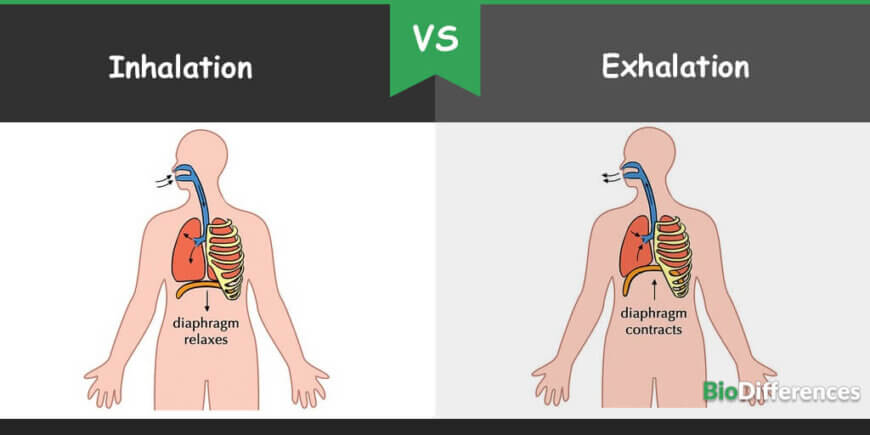Inhalation is the process of taking in air rich with oxygen whereas exhalation is the process of giving out air containing carbon dioxide.

Both inhalation and exhalation are parts of breathing. Breathing rate varies from person to person and depends on the kind of activity they perform in a day. The average rate of breathing in an adult is 15 to 18 times a minute. However, it may increase up to 25 times per minute in case of heavy exercise, running or fast walking.
Breathing is sometimes confused with the respiration. Breathing can be said as the process of exchanging gases from the lungs with the help of respiratory organs. The mechanism of breathing follows Boyle’s Law which states that pressure and volume have an inverse relationship.
On the other hand, respiration is a complete biochemical process in which the cells of organisms gain energy by combining oxygen and glucose and gives out carbon dioxide, ATP, and water.
Contents
Comparison Chart
| Basis for Comparison | Inhalation | Exhalation |
| Definition | The act of inhaling or breathing in is called inhalation. | The act of exhaling or breathing out is called exhalation. |
| Alternate Name | Inspiration | Expiration |
| Type of process | Active | Passive |
| Behavior of chest | Expands | Reduces |
| Behavior of diaphragm | Show contraction gets flattened by moving down | Show relaxation moves up forming a dome shape |
| The behavior of Intercostal muscle | Relaxation of internal intercostal muscles and contraction of external intercostal muscles | Contraction of internal intercostal muscles and relaxation of internal intercostal muscles |
| Lungs volume | Raises to cause inflation | Reduces to cause deflation |
| Air Pressure | Reduces inside the lungs | Increases inside the lungs |
| Function | Supply of oxygen-rich air to the blood | Expulsion of carbon dioxide |
| Composition of air | A mixture of oxygen and nitrogen | A mixture of nitrogen and carbon dioxide |
| Behavior of ribcage | Ribcage moves upward and outwards | Ribcage moves downwards |
What is Inhalation?
Inhalation is also known as “breathing in”. When we breathe in or inhale the air through the nostrils, it then passes through the nasal cavity, from where the air rich in oxygen reaches the lungs through the windpipe.
The lungs are surrounded by the ribs and located in the chest cavity. Ribs from the cage-like structure called rib-cage and have a muscular sheet known as a diaphragm which lies at the bottom of the cavity.
During breathing, when the oxygen-rich air reaches the diaphragm, it contracts or tightens and moves downward. The space in the chest cavity increases and the place into which the lungs get to expand. The chest cavity also gets enlarged due to intercostal muscles present between the ribs. This helps in the contraction and pulling of rib cage both outward and upward.
When the lungs expand, air enters through the mouth or nose. This air travels downward through the windpipe and into the lungs. The air certainly reaches the alveoli, after passing through bronchial tubes. The air passes to the nearby capillaries through the thin walls of the alveoli. Now, this air moves to the blood from the air cavity with the help of a protein called hemoglobin.
At the same time, carbon dioxide also shifts from the capillaries to the air sacs. The movement of gas is through the pulmonary artery into the bloodstream from the right side of the heart. Further, this blood rich in oxygen is carried to the pulmonary veins through a network of capillaries. The role of the pulmonary vein is to deliver oxygen-rich blood to the left side of the heart. This side of the heart pumps the blood to the rest of the body. From there the blood moves into the surrounding tissues.
What is Exhalation?
Exhalation is also known as “breathing out”. This process is opposite to that of inhalation. In this process, there is no contraction of muscles so it is considered a passive process. In this, the diaphragm gets relaxed and moves upward into the chest cavity. Even the intercostal muscles between the ribs also get relax which reduces the area in the chest cavity.
Gradually, the area in the chest gets decreased and the air rich with carbon dioxide and a little amount of nitrogen forced to move out of the lungs and windpipe and finally out through the nose.
Key Differences
- Inhalation is the process of intake of air into the lungs whereas exhalation is the process of letting air out of the lungs.
- Inhalation is the active process whereas exhalation is the passive process.
- The diaphragm shows contraction during inhalation and gets flattens by moving down whereas the diagram shows the relaxation and turned into dome-shaped by moving up.
- During inhalation, intercostal muscles relax and external costal muscles contract whereas, in exhalation, internal intercostal muscles contract and external intercostal muscles relax.
- The volume of lungs increases during inhalation whereas the volume of lungs decreases during exhalation.
- The size of the chest cavity increases during inhalation whereas the size of the chest cavity decreases during exhalation.
- The air rich with oxygen is taken into the blood during inhalation whereas the air rich with carbon dioxide is pushed out during exhalation from the blood.
- The rib cage moves upward during the inhalation whereas the rib cage moves downward during exhalation.
- The air pressure decreases during inhalation whereas the air pressure increases during exhalation.
Key Similarities
- Both inhalation and exhalation are processes of breathing.
Conclusion
In conclusion, inhalation and exhalation are the opposite processes of breathing. They differ from each other in the behavior of chest cavity, diaphragm and intercostal muscles which act opposite in both processes.